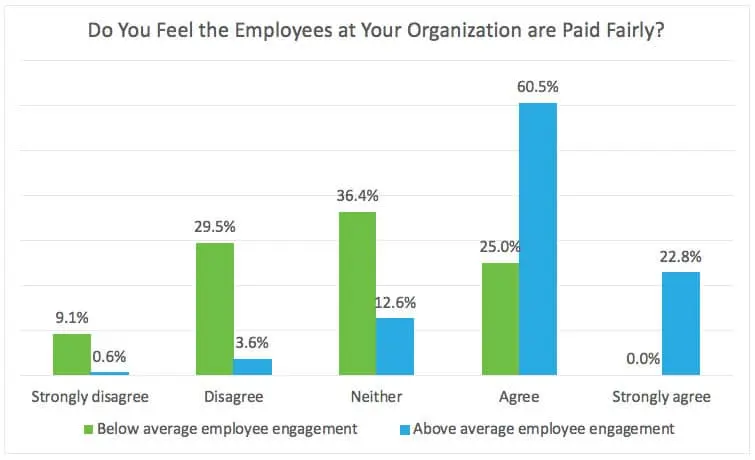Equitable Pay: The Modern Workforce Demands It

Throughout the employee cycle, equitable pay is one of the main drivers of employee engagement and retention. The modern workforce has never been more passionate about eliminating pay discrepancies and standing up for equitable pay – and they’ve never had more leverage to switch jobs.
However, 58% of participating organizations in Salary.com’s Pay Practices and Compensation Strategy do not have a formal process for addressing pay equity. To make matters worse, 63% of organizations that do not have a pay equity policy also stated they do not believe their employees were paid fairly.
Pay equity is not only critical for individual employees, but also has positive links to overall organizational culture. Defining a formal equitable pay strategy is critical to improve employee perceptions of pay fairness in your organization.
What Does Equitable Pay Mean?
Equitable pay refers to internal consistency of salary amongst employees within an organization. Internally equitable salary structure will help ensure employees receive proportionally fair treatment in terms of pay, anchored on clearly-defined expectations, as regularly communicated by the employer.
The Storied Legal Background on Equitable Payments
Several U.S. federal laws have helped combat discrimination against women and other minorities in the workplace. Among the most notable are:
- The Equal Pay Act (1963) – amended the Fair Labor Standards Act (FSLA) of 1938 to abolish wage disparity based on sex.
- Title VII of the Civil Rights Act (1964) – prohibits discrimination in all aspects of employment, including compensation, based on race, color, religion, national origin, and gender.
- Age Discrimination in Employment Act (1967) – prohibits discrimination in all aspects of employment for persons 40 years of age or older.
- Americans with Disabilities Act (1990) – prohibits discrimination in all facets of public life, including jobs, schools, transportation, and all public and private places that are open to the general public.
In addition, 47 U.S. states have varying levels of pay equity protections in place; 22 have just gender-specific laws, and 25 have gender plus other categories. As of March 2019, the three states relying solely on federal pay equity protections are Alabama, Michigan, and North Carolina.
Can an Employer Pay Different Wages for the Same Job?
Managing pay equity is a fundamental part of an HR professional’s role. There are several factors that influence pay variances between employees:
- Organizational & Occupational Factors – Variables such as company size and industry help explain the raw, unadjusted pay wage variance. For instance, it is harder to get trained on pharmaceuticals than retail, so pharma may carry a higher wage.
- Human Capital – At the individual level, compensable factors such as an employee’s location, educational background, and years of experience influence pay.
People often think of pay inequity as associated with male vs. female pay variances, which is covered at length in Understanding the Gender Pay Gap in America. The gender pay gap is decades in the making and will likely take years to completely erase, but organizations can play a role in helping close it. A recent study by Gartner estimates that 27% of factors contributing to overall inequity is within HR’s control.
By identifying the factors that are preventing equitable pay within your own salary structure, you can help close wage gaps and give your organization a distinct competitive advantage throughout the employee cycle.
Competitive Advantages of Embracing Equitable Pay
There is evidence of how an equitable salary can improve employer brand reputation and positively impact employee morale and performance. Statistics from Aptitude Research Partners associate organizations with a formal pay equity process to:
- Stronger Candidates – During pre-employment, 26% more likely to improve their quality of hire.
- Increased Employee Morale – 13% higher employee engagement.
- Improved Company Rankings – 43% more likely to have Glassdoor ratings improve versus year ago.
- Greater Revenue – 19% more likely to exceed industry-average levels of productivity.
- Exceeding Expectations – 54% more likely to beat industry-average turnover benchmarks.
Results from our survey reflect these trends. Organizations that perceive themselves as having high employee engagement are much more likely to also believe the employees in their organization are being paid fairly. In fact, these metrics correlated such that no organizations rating themselves below average for employee engagement “strongly agreed” that their employees are paid fairly.

Not Addressing Equitable Pay Will Result in Turnover
The consequences of not addressing pay equity are substantial. Given sky-high turnover rates (19.3% on average across the U.S.) and a record number of employees switching jobs or entering voluntarily unemployment for higher pay, the mere perception of unfair pay is enough to sink an organization.
If an employee perceives a pay gap (whether it exists or not), there is a 16% increase in their intent to leave. According to Gartner, this is an equivalent impact to believing they could earn 30% more doing the same job at another company.
Ensuring all employees are paid an equitable salary is a complex process, but can certainly be achieved if your organization puts in the time and resources.
Insights You Need to Get It Right





